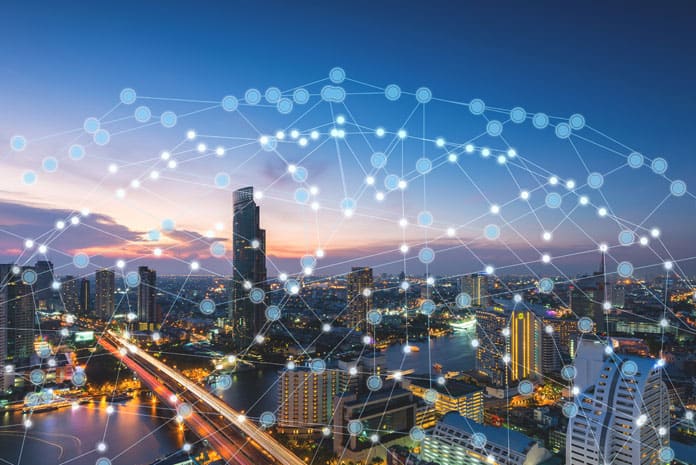By Sanjeev Azad, Vice-President – Technology, GlobalLogic
You may have heard about NEOM’s The Line project, which claims to be the world’s first cognitive city but appears to be far in the future. We have all heard of Smart Cities, but what are Cognitive Cities? They are the cities that use advanced technologies to enhance the way cities’ function and the quality of life for their residents. The idea behind it is to harness the power of technology to collect & analyze data about numerous aspects of city life, such as traffic patterns, energy usage, and public services. This would translate into making more informed decisions about how to manage and improve the city.
Cognitive cities can use this data to optimize city services, such as transportation and energy, and to improve the efficiency of city operations. For example, a cognitive city might use data analysis to identify traffic congestion and then implement solutions to reduce the number of cars on the road and improve traffic flow. In addition to improving city operations, cognitive cities can use sensors, can monitor air quality, implement smart parking systems to reduce congestion, and utilize online platforms to engage and gather feedback from residents.
But one might wonder, what exactly differentiates a smart city from a cognitive city? Primarily, a cognitive city uses AI to learn from data and make predictions and recommendations, while a smart city relies more on data analysis and decision-making by humans. Cognitive cities are being developed by numerous organizations and individuals, including governments, technology companies, and research institutions. Building a cognitive city requires a combination of data gathering, analysis, and solution development to identify and address the challenges and opportunities that the city faces.
Advantages of cognitive cities adoption
- Improved quality of life for residents: Collect and analyze data on various aspects of the city, cognitive cities can help city planners and decision-makers identify solutions to challenges facing the city, such as traffic congestion, energy efficiency, and public safety.
- Economic development: Cognitive cities can help attract new businesses and investment to the city, which can stimulate economic growth and create new job opportunities for residents.
- Enhanced public services: Improve the delivery of public services, such as transportation, healthcare, and education. For example, AI and data analytics tools can be used to optimize routes for public transport, improve the efficiency of healthcare services, and personalize learning experiences for students.
- Environmental sustainability: Monitor and manage the city’s natural resources, such as water and energy, more sustainably and efficiently. This can help reduce the city’s environmental impact and improve its overall sustainability.
Building blocks for cognitive cities
Key technologies, processes, and approaches are required to create and maintain these types of cities, which include:
- Sensors and other data-gathering technology: Cognitive cities collect data about various aspects of city life, such as traffic patterns, energy usage, and public services, using sensors and other technologies. This information is crucial for the city to be able to make well-informed management and improvement decisions.
- Data analysis and visualization tools: Once the data has been collected, it must be evaluated and represented visually to reveal patterns and trends. This can be done by using techniques for evaluating and visualizing something to learn more about it and make it easier to understand and use.
- Advanced Technologies (AI, ML, IoT, Cloud, and Edge Computing): AI and ML are key technologies for cognitive cities, as they allow the city to learn from data and make predictions and recommendations. IoT platforms are used to connect the various sensors and devices in a cognitive city, allowing them to share data and communicate with each other. This enables the city to collect and analyze data from multiple sources, and to use that data to make more informed decisions. Cloud computing technologies can be used to store, manage, and analyze large amounts of data collected by sensors and IoT devices. Centralized cloud and distributed or edge computing are the backbone of any smart ecosystem and the same will continue to be the primary building blocks for developing cognitive ecosystems.
- User interfaces and applications: Finally, cognitive cities often have user interfaces and applications that allow city officials, businesses, and residents to access and interact with the data and technologies used by the city. This can include mobile apps, web portals, and other user-friendly interfaces.
- Citizen engagement: In a cognitive city, citizens are actively involved in the decision-making process, providing feedback and suggestions that can help shape the city’s policies and initiatives.
- Infrastructure and connectivity: Cognitive cities require reliable and high-speed connectivity to support the vast amounts of data that are generated and processed. This includes both physical infrastructure, such as roads and bridges, and digital infrastructures, such as broadband networks and 5G connectivity.
Cognitive cities offer several potential business use cases, as the data and insights generated by these cities can be valuable for a wide range of businesses across industries such as transportation and logistics, retail and e-commerce, energy and utilities, real estate and property management, and healthcare and wellness.
While it is ambitious to project its exact market size as the field is relatively new and evolving, however, there is significant interest in and demand for cognitive cities, and is likely to grow in the coming years. One recent study estimated that the global market for smart cities, which includes cognitive cities, will reach $2.57 trillion by 2025, with a CAGR of 22.8%. Overall, the future of cognitive cities will be more characterized by greater integration with advanced technologies, and increased collaboration among cities.











Thank you for the effort expended in research, writing and publishing.